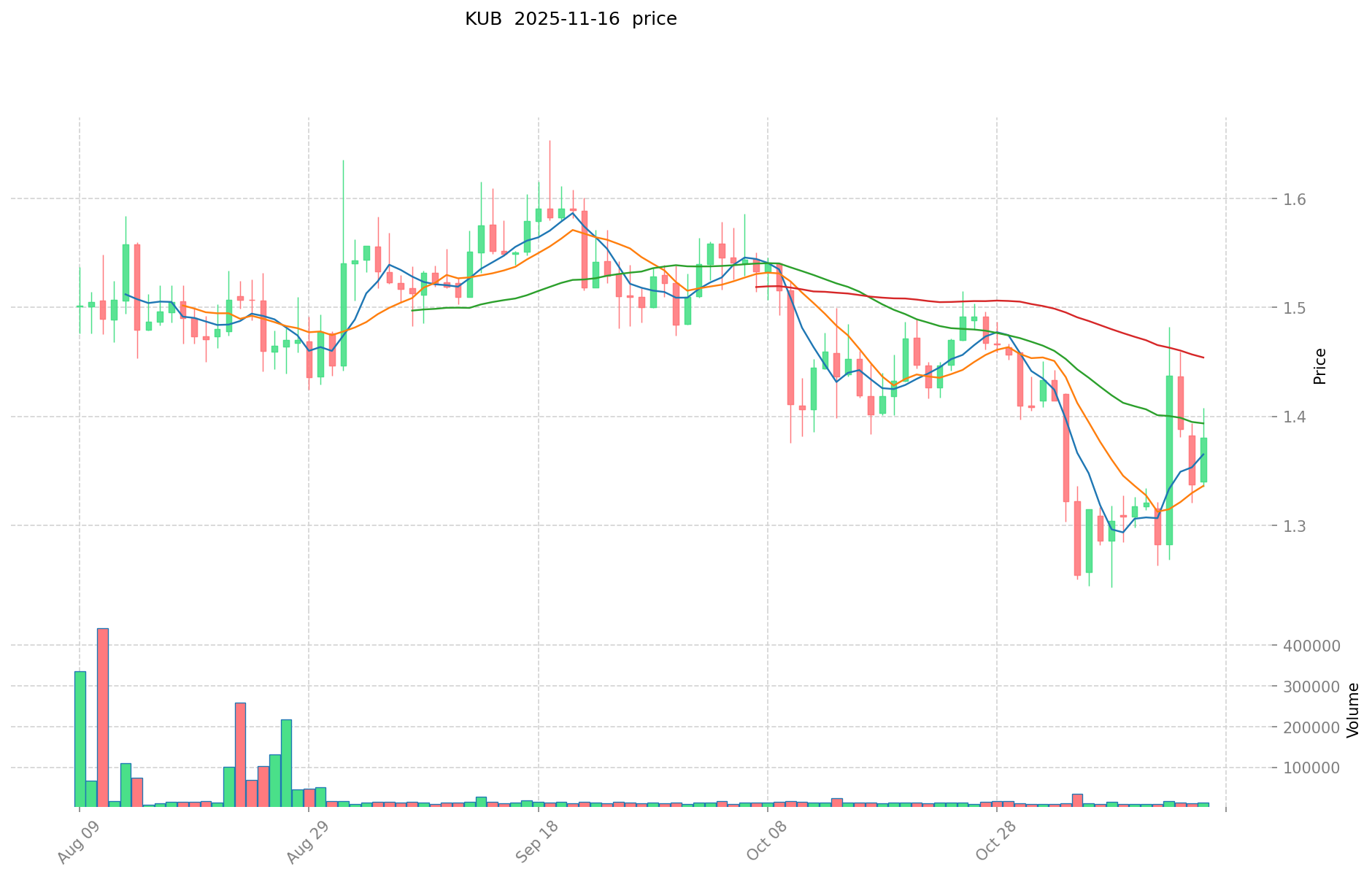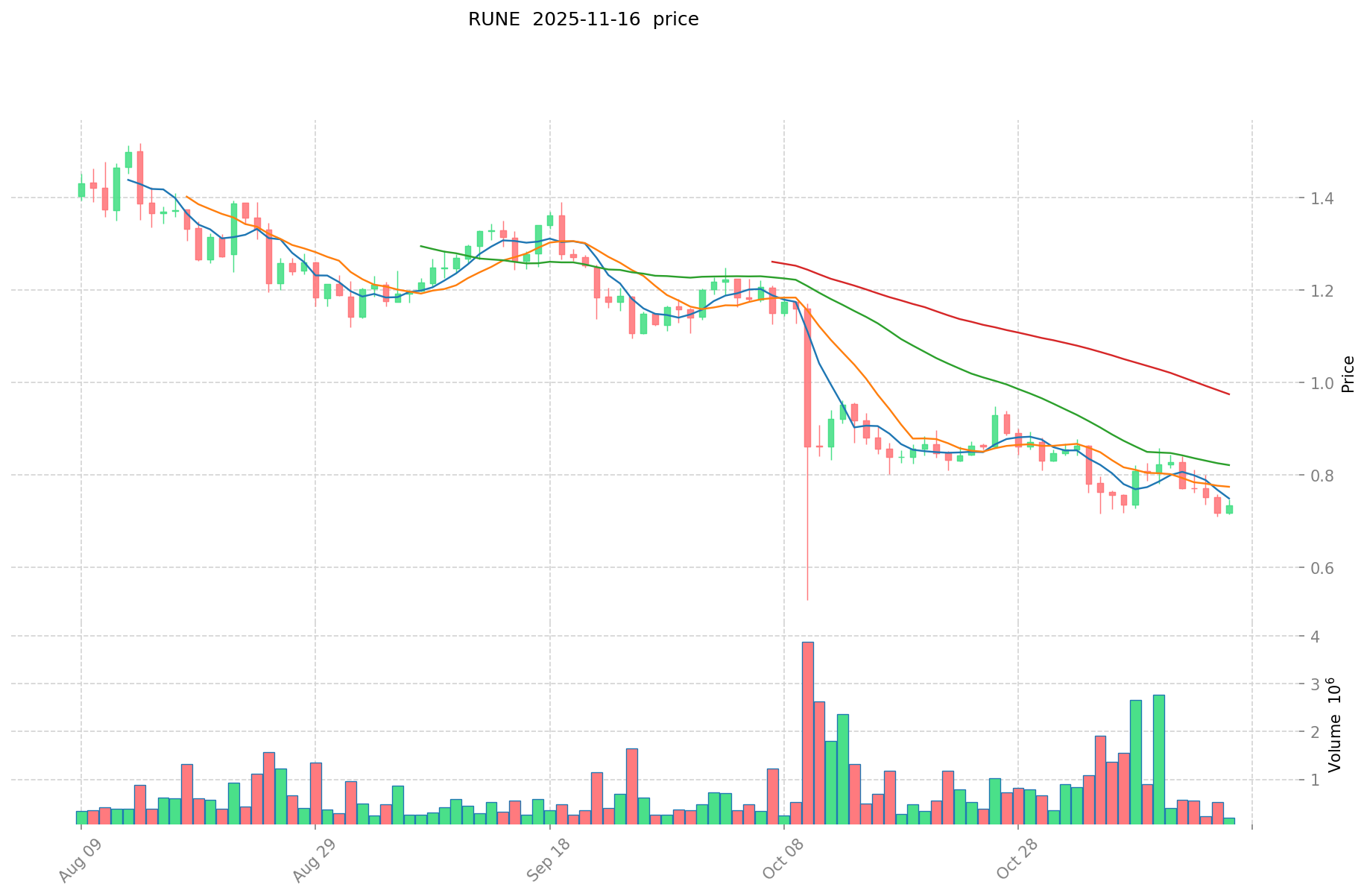KUB vs RUNE: The Battle of Decentralized Liquidity Protocols
Introduction: Investment Comparison of KUB vs RUNE
In the cryptocurrency market, the comparison between KUB vs RUNE has always been an unavoidable topic for investors. The two not only have significant differences in market cap ranking, application scenarios, and price performance, but also represent different cryptocurrency asset positions.
KUB (KUB): Since its launch, it has gained market recognition for its role in the Bitkub Chain ecosystem.
RUNE (RUNE): Since its inception in 2019, it has been hailed as a multi-chain solution, and is one of the cryptocurrencies with high global trading volume and market capitalization.
This article will comprehensively analyze the investment value comparison between KUB vs RUNE, focusing on historical price trends, supply mechanisms, institutional adoption, technological ecosystems, and future predictions, and attempt to answer the question that investors are most concerned about:
"Which is the better buy right now?"
I. Price History Comparison and Current Market Status
KUB and RUNE Historical Price Trends
- 2021: KUB reached its all-time high of $17.24 on December 28, 2021.
- 2021: RUNE achieved its all-time high of $20.87 on May 19, 2021.
- Comparative analysis: In the current market cycle, KUB has fallen from its all-time high of $17.24 to a current price of $1.3708, while RUNE has dropped from its peak of $20.87 to $0.7407.
Current Market Situation (2025-11-16)
- KUB current price: $1.3708
- RUNE current price: $0.7407
- 24-hour trading volume: KUB $18,120.82 vs RUNE $144,459.05
- Market Sentiment Index (Fear & Greed Index): 10 (Extreme Fear)
Click to view real-time prices:
- View KUB current price Market Price
- View RUNE current price Market Price


II. Core Factors Affecting the Investment Value of KUB vs RUNE
Supply Mechanism Comparison (Tokenomics)
- KUB: Fixed supply with a maximum cap of 100 million tokens, following a deflationary model with token burning mechanisms
- RUNE: Dynamic supply with bonding mechanism where RUNE is minted or burned based on liquidity provision, featuring a maximum supply of 500 million tokens
- 📌 Historical Pattern: Deflationary assets like KUB tend to perform better in bull markets, while RUNE's dynamic supply model helps maintain economic equilibrium during market volatility.
Institutional Adoption and Market Applications
- Institutional Holdings: RUNE has gained more institutional interest due to THORChain's cross-chain capabilities and liquidity provision solutions
- Enterprise Adoption: KUB is being utilized in Bitkub's ecosystem for trading fee discounts and governance, while RUNE serves as the backbone for THORChain's decentralized liquidity network
- Regulatory Attitudes: KUB benefits from clearer regulatory status in Southeast Asia, particularly Thailand, while RUNE faces more regulatory uncertainty in multiple jurisdictions
Technical Development and Ecosystem Building
- KUB Technical Upgrades: Integration with Bitkub Chain for expanding DeFi applications and NFT marketplace development
- RUNE Technical Development: Continuous improvements to THORChain's cross-chain liquidity protocol and addition of new blockchain integrations
- Ecosystem Comparison: RUNE offers stronger DeFi capabilities through native cross-chain swaps, while KUB provides a more centralized but regionally focused ecosystem in Southeast Asia
Macroeconomic and Market Cycles
- Inflation Performance: RUNE has demonstrated stronger anti-inflationary properties due to its utility in securing cross-chain liquidity
- Macro Monetary Policy: Both tokens show sensitivity to interest rate changes, with KUB potentially more stable during market downturns due to regional adoption
- Geopolitical Factors: KUB benefits from growing crypto adoption in Southeast Asia, while RUNE's global, cross-chain nature provides broader exposure to international market dynamics
III. 2025-2030 Price Prediction: KUB vs RUNE
Short-term Prediction (2025)
- KUB: Conservative $1.05 - $1.36 | Optimistic $1.36 - $1.42
- RUNE: Conservative $0.39 - $0.74 | Optimistic $0.74 - $0.86
Mid-term Prediction (2027)
- KUB may enter a growth phase, with estimated prices of $1.37 - $2.06
- RUNE may enter a growth phase, with estimated prices of $0.85 - $1.02
- Key drivers: Institutional fund inflows, ETFs, ecosystem development
Long-term Prediction (2030)
- KUB: Base scenario $2.16 - $2.37 | Optimistic scenario $2.37 - $3.14
- RUNE: Base scenario $1.31 - $1.42 | Optimistic scenario $1.42 - $1.84
Disclaimer
KUB:
| 年份 | 预测最高价 | 预测平均价格 | 预测最低价 | 涨跌幅 |
|---|---|---|---|---|
| 2025 | 1.419392 | 1.3648 | 1.050896 | 0 |
| 2026 | 1.90717152 | 1.392096 | 1.33641216 | 1 |
| 2027 | 2.0620422 | 1.64963376 | 1.3691960208 | 20 |
| 2028 | 2.0599801578 | 1.85583798 | 1.113502788 | 35 |
| 2029 | 2.369069973369 | 1.9579090689 | 1.860013615455 | 42 |
| 2030 | 3.137059805645025 | 2.1634895211345 | 1.103379655778595 | 57 |
RUNE:
| 年份 | 预测最高价 | 预测平均价格 | 预测最低价 | 涨跌幅 |
|---|---|---|---|---|
| 2025 | 0.860372 | 0.7417 | 0.393101 | 0 |
| 2026 | 1.0813986 | 0.801036 | 0.5607252 | 8 |
| 2027 | 1.016514684 | 0.9412173 | 0.84709557 | 27 |
| 2028 | 1.40956702848 | 0.978865992 | 0.85161341304 | 32 |
| 2029 | 1.4211176471856 | 1.19421651024 | 1.0986791894208 | 61 |
| 2030 | 1.843810580985048 | 1.3076670787128 | 0.928443625886088 | 76 |
IV. Investment Strategy Comparison: KUB vs RUNE
Long-term vs Short-term Investment Strategies
- KUB: Suitable for investors focused on regional ecosystem growth and Southeast Asian market potential
- RUNE: Suitable for investors interested in cross-chain DeFi solutions and global liquidity provision
Risk Management and Asset Allocation
- Conservative investors: KUB: 40% vs RUNE: 60%
- Aggressive investors: KUB: 60% vs RUNE: 40%
- Hedging tools: Stablecoin allocation, options, cross-currency portfolio
V. Potential Risk Comparison
Market Risks
- KUB: Concentration risk in Southeast Asian markets, potential volatility due to regional economic factors
- RUNE: Higher exposure to global market fluctuations, susceptibility to broader crypto market trends
Technical Risks
- KUB: Scalability, network stability within the Bitkub Chain ecosystem
- RUNE: Complexity of cross-chain operations, potential security vulnerabilities in multi-chain integrations
Regulatory Risks
- Global regulatory policies may have different impacts on both tokens, with KUB potentially facing more localized regulatory scrutiny in Southeast Asia, while RUNE may encounter diverse regulatory challenges across multiple jurisdictions
VI. Conclusion: Which Is the Better Buy?
📌 Investment Value Summary:
- KUB advantages: Strong regional focus, integration with established exchange ecosystem, potential for growth in Southeast Asian markets
- RUNE advantages: Cross-chain liquidity solutions, broader DeFi applications, global market exposure
✅ Investment Advice:
- New investors: Consider a balanced approach with a slight preference for KUB due to its more straightforward ecosystem and regional strength
- Experienced investors: Explore opportunities in both tokens, with a potential tilt towards RUNE for its advanced DeFi capabilities
- Institutional investors: Consider a diversified approach, leveraging KUB for regional exposure and RUNE for global DeFi market participation
⚠️ Risk Warning: The cryptocurrency market is highly volatile, and this article does not constitute investment advice. None
VII. FAQ
Q1: What are the main differences between KUB and RUNE? A: KUB is focused on the Bitkub Chain ecosystem in Southeast Asia with a fixed supply, while RUNE is a cross-chain liquidity solution with a dynamic supply mechanism. KUB has a maximum cap of 100 million tokens, while RUNE has a maximum supply of 500 million tokens.
Q2: Which token has performed better historically? A: Both tokens reached their all-time highs in 2021, with KUB peaking at $17.24 and RUNE at $20.87. Currently, KUB is trading at $1.3708, while RUNE is at $0.7407, representing significant declines from their peak values.
Q3: What are the key factors affecting the investment value of KUB and RUNE? A: Key factors include supply mechanisms, institutional adoption, technical development, ecosystem building, macroeconomic conditions, and market cycles. KUB benefits from regional adoption in Southeast Asia, while RUNE offers broader exposure to global DeFi markets.
Q4: What are the price predictions for KUB and RUNE in 2030? A: For KUB, the base scenario predicts $2.16 - $2.37, with an optimistic scenario of $2.37 - $3.14. For RUNE, the base scenario predicts $1.31 - $1.42, with an optimistic scenario of $1.42 - $1.84.
Q5: How should investors allocate their assets between KUB and RUNE? A: Conservative investors might consider allocating 40% to KUB and 60% to RUNE, while aggressive investors might opt for 60% KUB and 40% RUNE. However, individual allocations should be based on personal risk tolerance and investment goals.
Q6: What are the main risks associated with investing in KUB and RUNE? A: Market risks include regional concentration for KUB and global market exposure for RUNE. Technical risks involve scalability issues for KUB and cross-chain operation complexities for RUNE. Both face regulatory risks, with KUB potentially facing more localized scrutiny in Southeast Asia.
Q7: Which token is better for new investors? A: New investors might consider a balanced approach with a slight preference for KUB due to its more straightforward ecosystem and regional strength. However, the choice ultimately depends on individual investment goals and risk tolerance.
Share
Content